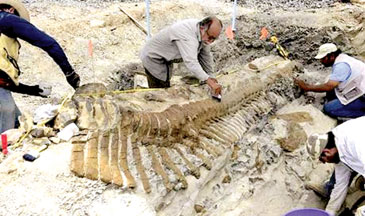Huge dinosaur tail discovered in Mexico
A giant dinosaur tail has been uncovered in northern Mexico,
palaeontologists announced.
The well-preserved tail measures about 16 feet (five metres) long,
contains 50 vertebrate, and seems to have belonged to a
 hadrosaur - a duck-billed dino that lived about 72 million years ago.
Hadrosaurs grew to be about 40 feet (12 m) long, so the tail would have
taken up just under half the length of its body. hadrosaur - a duck-billed dino that lived about 72 million years ago.
Hadrosaurs grew to be about 40 feet (12 m) long, so the tail would have
taken up just under half the length of its body.
Buried within sedimentary rock in the desert region of Coahulia, this
is the first intact dinosaur tail of this size to be discovered in
Mexico, and only one of a handful that has been discovered around the
world, according to a statement from the Mexican National Institute for
Anthropology and History (INAH). Back in 2008, archaeologists reported
the discovery of another hadrosaur, dubbed Velafrons coahuilensis, found
in Coahulia.
That specimen likely belonged to a juvenile dinosaur; even so it the
youngster would have been 25 feet (7.5 m) in length, suggesting V.
coahuilensis adults grew to a whopping 30 to 35 feet (9 to 10.5 m) long.
A group of locals discovered the fossil in June 2012.
Palaeontologists with INAH and the National Autonomous University of
Mexico spent about a year surveying the area, and began their excavation
on July 2.
The team has uncovered other bones from this dinosaur aside from tail
vertebrae along the way, including its hip bone, and believes that more
of the animal could be buried deeper within the rock.
They originally planned to dig a plot 10 feet by 20 feet wide (3 by 6
metres), but have since decided to expand to 13 feet by 26 feet (4 by 8
metres) to follow the sprawling orientation of the bones, said
excavation-leader Felisa Aguilar in a statement. Aside from providing a
valuable addition to the world's limited collection of intact dinosaur
fossils, the team hopes their findings will help explain the mechanics
of how hadrosaur tails moved, said team member Angel Ramirez Velasco
from the National Autonomous University of Mexico in a statement.
The bones will be transported in separate parts to the city of
General Cepeda, where they will be cleaned and analysed in further
detail.
- LiveScience
|


